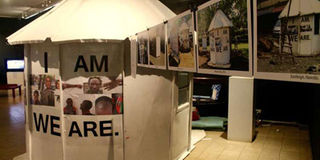Echoes of nationhood in the Silent Room

The Silent Room where 1,600 Kenyans were interviewed for the project. Long-running project now displayed at the National Museums explores ideas of Kenyan identity, seeking answers to the question: ‘Who I Am, Who We Are’. PHOTO | JAN FOX
What you need to know:
- If at a particular moment. She feels that every Kenyan is a “chameleon” in this sense — that they align themselves ethnically or nationally whenever the situation suits it.
- Another interesting perspective is that of an elderly Eastern European woman who spent most of her life studying and recording Samburu culture. Though she considers herself to be Kenyan, she feels she will never be accepted as a Kenyan because of her background and colour.
- One artist — a Kalenjin married to a Kisii and living in Kisumu — uses his body map to portray his struggles with acceptance. “I was told not to marry a Kisii. People believe that Kisiis eat people and practise witchcraft... They now understand because I have not been eaten as they thought”.
Are you Kenyan? How are you similar to other Kenyans? How are you different from other Kenyans? What makes you proud about Kenya? What does not make you proud about Kenya? What does it mean to be Kenyan? How do you see yourself in five years, in Kenya?
Some 1,600 Kenyans gave responses to these questions as part of a long-running project called “Who I Am, Who We Are”, which explores ideas of Kenyan nationhood and identity. Between 2013 and 2015, the project’s artists toured the country recording these responses in a public installation called ‘In a Silent Room’.
Another feature of the project involved “body mapping” — where volunteers lie down on a large white canvas, are outlined and then tell their story by painting and writing an accompanying narrative. On their travels, the project’s artists also conducted 80 interviews, took 2,000 photographs and filmed nine documentaries.
The project is the brainchild of artists Wambui Kamiru and Xavier Verhoest. Xavier has worked in Kenya as a multimedia artist, curator and public art project coordinator, and in 2006 co-founded ‘Art2Be’ — a group of international and Kenyan artists and therapists who aim to bring social change to marginalised groups.
This current project is much broader, and aims to collect people’s perceptions of themselves as Kenyans, their relationship with other Kenyans, and their views about some key events over the 50 years since independence.
It describes itself as “a project about the idea of nationhood and how it is embodied through our sense of identity and our everyday actions”. It aims to “act as a catalyst for reflection and contribution to the conversation/debate on the path taken by Kenya since 1963 into the future”.
CHAMELEONE IDENTITY
A selection of the recorded interviews, paintings, stories, films and photographs are now showcased at the project’s first major exhibition at the Nairobi National Museum. You’ll find it next to the rather strange exhibit called “Poland’s Forests”, a room full of open suitcases filled with saplings.
In addition to the Silent Room — a simple white tin hut with a single chair and a microphone — the exhibition features a handful of the 80 body maps and their accompanying stories. Those displayed were painted by Kenyans from a wide variety of racial, ethnic and socio-economic backgrounds, and present a fascinating array of perceptions of what it means to be Kenyan.
Those that caught my eye included a body map painted by a young resident of Eastleigh, originally from Mandera. “I chose to stand on one leg”, he says, “because most Kenyans do not recognise me fully as Kenyan. They call me a Kenyan Somali. At times they take my ID card and then take me to Kasarani where I have to purchase my freedom”. The snakes beneath his feet, painted in Kenya’s black, red and green, signify that he is bitten whether he moves forwards or backwards.
These thoughts are echoed by another artist of Somali origin, who struggled to answer the question: Are you Kenyan? Her response was: “We are what is convenient; we are what we want to be in a particular moment to work. If at a particular moment. She feels that every Kenyan is a “chameleon” in this sense — that they align themselves ethnically or nationally whenever the situation suits it.
Another interesting perspective is that of an elderly Eastern European woman who spent most of her life studying and recording Samburu culture. Though she considers herself to be Kenyan, she feels she will never be accepted as a Kenyan because of her background and colour. “I do feel black”, she says, “I am Samburu in my heart and soul... this is what makes me belong here”.
One artist — a Kalenjin married to a Kisii and living in Kisumu — uses his body map to portray his struggles with acceptance. “I was told not to marry a Kisii. People believe that Kisiis eat people and practise witchcraft... They now understand because I have not been eaten as they thought”.
Questions of identity — of what it means to be Kenyan — have taken on particular significance over the past few years. The 2007 post-election violence fuelled perceptions of an identity crisis that have only recently been blunted by peaceful elections in 2013, and by the subsequent celebration of 50 years of independence.
So the Who I Am, Who We Are project is as important as it is fascinating. It creates space for introspection and dialogue. The show runs till the end of February, and is well worth a visit.





